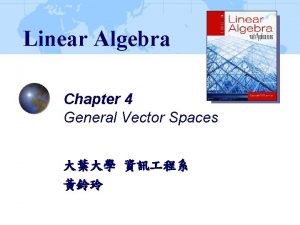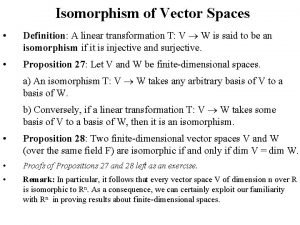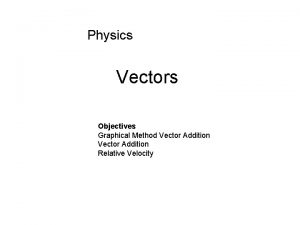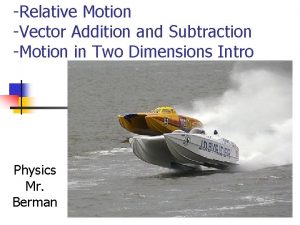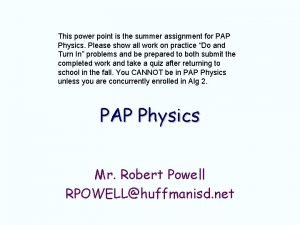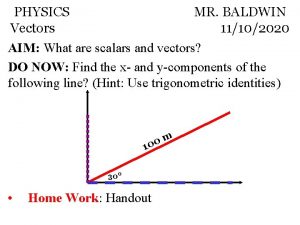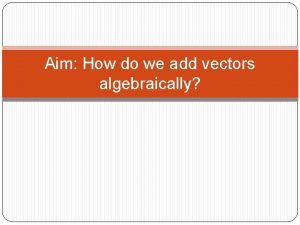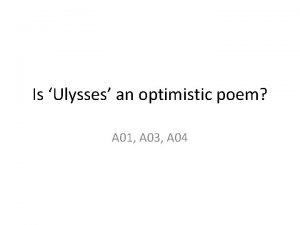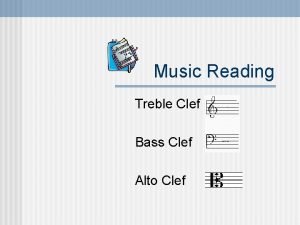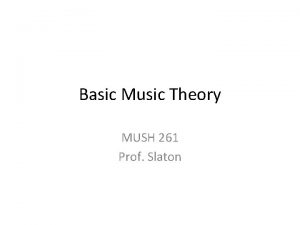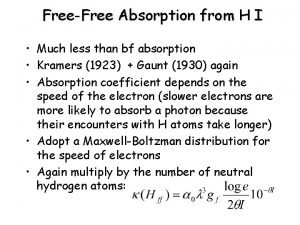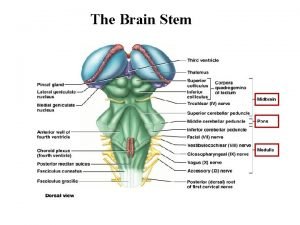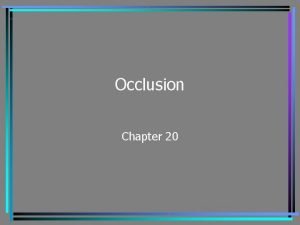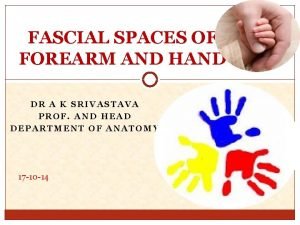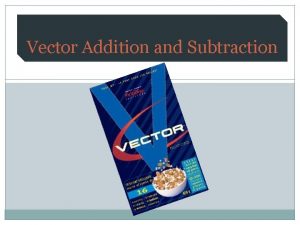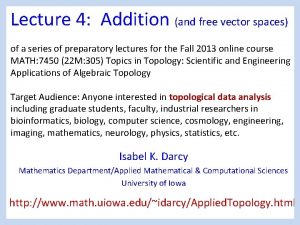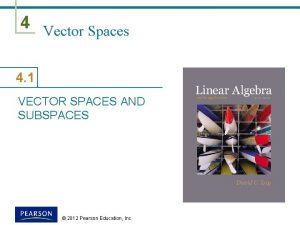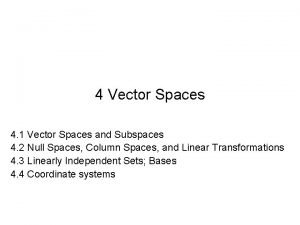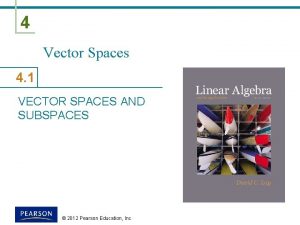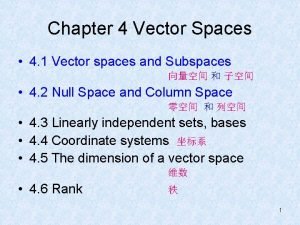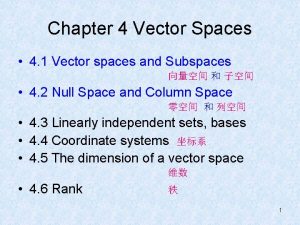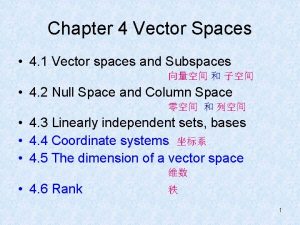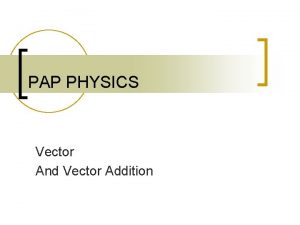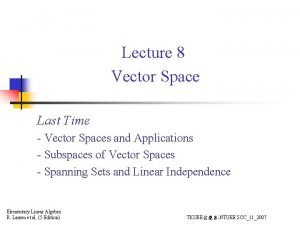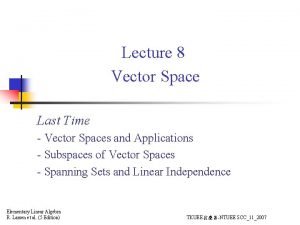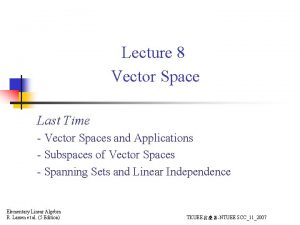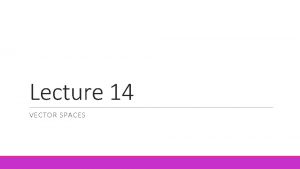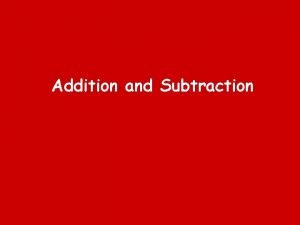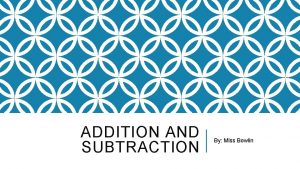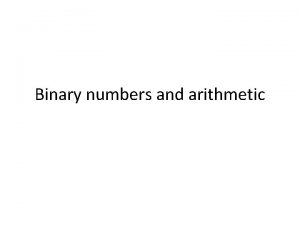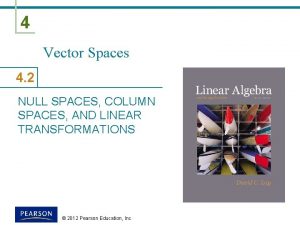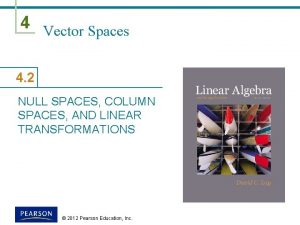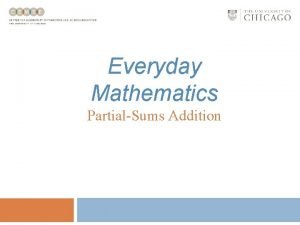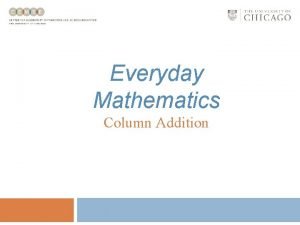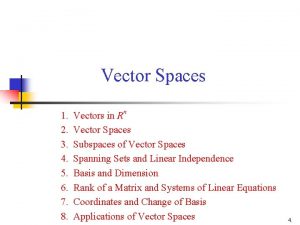Lecture 4 Addition and free vector spaces of






















![In Z[e 1, e 2, e 3, e 4, e 5] Objects: oriented edges In Z[e 1, e 2, e 3, e 4, e 5] Objects: oriented edges](https://slidetodoc.com/presentation_image/3baaf6d2ccb9f8136ba3219348bb9b18/image-23.jpg)
![In Z[e 1, e 2, e 3, e 4, e 5] Objects: oriented edges In Z[e 1, e 2, e 3, e 4, e 5] Objects: oriented edges](https://slidetodoc.com/presentation_image/3baaf6d2ccb9f8136ba3219348bb9b18/image-24.jpg)
![In Z[e 1, e 2, e 3, e 4, e 5] Objects: oriented edges In Z[e 1, e 2, e 3, e 4, e 5] Objects: oriented edges](https://slidetodoc.com/presentation_image/3baaf6d2ccb9f8136ba3219348bb9b18/image-25.jpg)
![In Z[e 1, e 2, e 3, e 4, e 5] Objects: oriented edges In Z[e 1, e 2, e 3, e 4, e 5] Objects: oriented edges](https://slidetodoc.com/presentation_image/3baaf6d2ccb9f8136ba3219348bb9b18/image-26.jpg)
![In Z[e 1, e 2, e 3, e 4, e 5] e 1 e In Z[e 1, e 2, e 3, e 4, e 5] e 1 e](https://slidetodoc.com/presentation_image/3baaf6d2ccb9f8136ba3219348bb9b18/image-27.jpg)
![In Z 2[e 1, e 2, e 3, e 4, e 5] e 1 In Z 2[e 1, e 2, e 3, e 4, e 5] e 1](https://slidetodoc.com/presentation_image/3baaf6d2ccb9f8136ba3219348bb9b18/image-28.jpg)

![In Z[e 1, e 2, e 3, e 4, e 5] v 2 e In Z[e 1, e 2, e 3, e 4, e 5] v 2 e](https://slidetodoc.com/presentation_image/3baaf6d2ccb9f8136ba3219348bb9b18/image-30.jpg)


![In Z[f] Add an oriented face v 2 e 1 v 1 e 4 In Z[f] Add an oriented face v 2 e 1 v 1 e 4](https://slidetodoc.com/presentation_image/3baaf6d2ccb9f8136ba3219348bb9b18/image-33.jpg)

![In Z 2[f] Add a face v 2 e 1 v 1 e 4 In Z 2[f] Add a face v 2 e 1 v 1 e 4](https://slidetodoc.com/presentation_image/3baaf6d2ccb9f8136ba3219348bb9b18/image-35.jpg)


- Slides: 37

Lecture 4: Addition (and free vector spaces) of a series of preparatory lectures for the Fall 2013 online course MATH: 7450 (22 M: 305) Topics in Topology: Scientific and Engineering Applications of Algebraic Topology Target Audience: Anyone interested in topological data analysis including graduate students, faculty, industrial researchers in bioinformatics, biology, computer science, cosmology, engineering, imaging, mathematics, neurology, physics, statistics, etc. Isabel K. Darcy Mathematics Department/Applied Mathematical & Computational Sciences University of Iowa http: //www. math. uiowa. edu/~idarcy/Applied. Topology. html

A free abelian group generated by the elements x 1, x 2, …, xk consists of all elements of the form n 1 x 1 + n 2 x 2 + … + n k xk where ni are integers. Z = The set of integers = { …, -2, -1, 0, 1, 2, …} = the set of all whole numbers (positive, negative, 0) Addition: (n 1 x 1 + n 2 x 2 + … + nkxk) + (m 1 x 1 + m 2 x 2 + … + mkxk) = (n 1 + m 1) x 1 + (n 2 + m 2)x 2 + … + (nk + mk)xk

A free abelian group generated by the elements x 1, x 2, …, xk consists of all elements of the form n 1 x 1 + n 2 x 2 + … + n k xk where ni are integers. Example: Z[x , x ] 4 ix + 2 I x – 2 i -3 x k + n iii Z = The set of integers = { …, -2, -1, 0, 1, 2, …}

A free abelian group generated by the elements x 1, x 2, …, xk consists of all elements of the form n 1 x 1 + n 2 x 2 + … + n k xk where ni are integers. Z = The set of integers = { …, -2, -1, 0, 1, 2, …} = the set of all whole numbers (positive, negative, 0) Addition: (n 1 x 1 + n 2 x 2 + … + nkxk) + (m 1 x 1 + m 2 x 2 + … + mkxk) = (n 1 + m 1) x 1 + (n 2 + m 2)x 2 + … + (nk + mk)xk

A free vector space over the field F generated by the elements x 1, x 2, …, xk consists of all elements of the form n 1 x 1 + n 2 x 2 + … + n k xk where ni in F. Examples of a field: R = set of real numbers Q = set of rational numbers Z 2 = {0, 1} Addition: (n 1 x 1 + n 2 x 2 + … + nkxk) + (m 1 x 1 + m 2 x 2 + … + mkxk) = (n 1 + m 1) x 1 + (n 2 + m 2)x 2 + … + (nk + mk)xk

A free vector space over the field F generated by the elements x 1, x 2, …, xk consists of all elements of the form n 1 x 1 + n 2 x 2 + … + n k xk where ni in F. Examples of a field: R = set of real numbers: πx + √ 2 y + 3 z is in R[x, y, z] Q = set of rational numbers (i. e. fractions): (½)x + 4 y is in Q[x, y] Z 2 = {0, 1}: 0 x + 1 y + 1 w + 0 z is in Z 2[x, y, z, w]

Group Closure Associative Identity Inverses x, y in G implies x + y is in G (x + y) + z = x + (y + z) 0+x=x=x+0 x + (-x) = 0 = (-x) + x Examples of a group under addition: R = set of real numbers Q = set of rational numbers. Z = set of integers. Z 2 = {0, 1}

Group Closure Associative Identity Inverses Abelian Group Closure Associative Identity Inverses Commutative x, y in G implies x + y is in G (x + y) + z = x + (y + z) 0+x=x=x+0 x + (-x) = 0 = (-x) + x x+y=y+x

Abelian Group Closure Associative Identity Inverses Commutative x, y in G implies x + y is in G (x + y) + z = x + (y + z) 0+x=x=x+0 x + (-x) = 0 = (-x) + x x+y=y+x Examples of an abelian group under addition: R = set of real numbers Q = set of rational numbers. Z = set of integers. Z 2 = {0, 1}

Group Closure Associative Identity Inverses x, y in G implies x y is in G (x y) z = x (y z) 1 x = 1 x x (x-1) = 1 = (x-1) x Examples of a group under multiplication: R – {0} = set of real numbers not including zero. Q – {0} = set of rational numbers not including zero. Z 2– {0} = {1}

Group Closure Associative Identity Inverses x, y in G implies x y is in G (x y) z = x (y z) 1 x = 1 x x (x-1) = 1 = (x-1) x Note that Z – {0} is not a group under multiplication.

F is a field if (1) F is an abelian group under addition (2) F – {0} is an abelian group under multiplication (3) multiplication distributes across addition. Field Closure Associative Identity Inverses Commutative Distributive Addition x, y in G x+ y in G (x + y) + z = x + (y + z) 0+x=x=x+0 x + (-x) = 0 = (-x) + x x+y=y+x x(y+z) = Multiplication closure (x y) z = x (y z) 1 x = 1 x x (x-1) = 1 = (x-1) x (x y) z = x (y z) xy+xz Examples of a field: R = set of real numbers Q = set of rational numbers Z 2 = {0, 1}

A free vector space over the field F generated by the elements x 1, x 2, …, xk consists of all elements of the form n 1 x 1 + n 2 x 2 + … + n k xk where ni in F. Examples of a field: R = set of real numbers Q = set of rational numbers Z 2 = {0, 1} Addition: (n 1 x 1 + n 2 x 2 + … + nkxk) + (m 1 x 1 + m 2 x 2 + … + mkxk) = (n 1 + m 1) x 1 + (n 2 + m 2)x 2 + … + (nk + mk)xk

A free abelian group generated by the elements x 1, x 2, …, xk consists of all elements of the form n 1 x 1 + n 2 x 2 + … + n k xk where ni are integers. Z = The set of integers = { …, -2, -1, 0, 1, 2, …} = the set of all whole numbers (positive, negative, 0) Addition: (n 1 x 1 + n 2 x 2 + … + nkxk) + (m 1 x 1 + m 2 x 2 + … + mkxk) = (n 1 + m 1) x 1 + (n 2 + m 2)x 2 + … + (nk + mk)xk

A free vector space over the field Z 2 generated by the elements x 1, x 2, …, xk consists of all elements of the form n 1 x 1 + n 2 x 2 + … + n k xk where ni in Z 2. Example: Z 2[x 1, x 2] = {0, x 1, x 2, x 1 + x 2} 4 x 1 + 2 x 2 = 0 x 1 + 0 x 2 = 0 mod 2 1 x 1 + 0 x 2 = x 1 mod 2 0 x 1 + 1 x 2 = x 2 mod 2 kx 1 + nx 2 mod 2 Z 2 = The set of integers mod 2 = {0, 1}

Addition: (n 1 x 1 + n 2 x 2 + … + nkxk) + (m 1 x 1 + m 2 x 2 + … + mkxk) = (n 1 + m 1) x 1 + (n 2 + m 2)x 2 + … + (nk + mk)xk Example: Z 2[x 1, x 2] = {0, x 1, x 2, x 1 + x 2} 1 x 1 + 1 x 1 = 2 x 1 = 0 mod 2 (x 1 + x 2) + (x 1 + 0 x 2) = 2 x 1 + x 2 = x 2 mod 2 (1 x 1 + 0 x 2) + (0 x 1 + 1 x 2) = x 1 + x 2 mod 2

Example 2 from lecture 3: 4 vertices + 5 edges 4 v + 5 e v = vertex e = edge

Example 2 from lecture 3: 0 vertices + 1 edges mod 2 0 v + 1 e = e mod 2 v = vertex e = edge

Example 2 from lecture 3: 0 vertices + 1 edges mod 2 0 v + 1 e = e mod 2 v = vertex e = edge

v 2 e 1 v 1 e 4 e 2 e 3 v 3 e 5 v 4 v 1 + v 2 + v 3 + v 4 + e 1 + e 2 + e 3 + e 4 + e 5 in Z 2[v 1, v 2, , v 3, v 4, e 1, e 2, , e 3, e 4, e 5]

v 2 e 1 v 1 e 4 e 2 e 3 v 3 e 5 v 4 v 1 + v 2 + v 3 + v 4 in Z[v 1, v 2, , v 3, v 4] e 1 + e 2 + e 3 + e 4 + e 5 in Z[e 1, e 2, , e 3, e 4, e 5]

v 2 e 1 v 1 e 4 Note that e 1 + e 2 + e 3 is a cycle. e 2 e 3 v 4 v 3 e 5 Note that e 3 + e 5 + e 4 is a cycle.
![In Ze 1 e 2 e 3 e 4 e 5 Objects oriented edges In Z[e 1, e 2, e 3, e 4, e 5] Objects: oriented edges](https://slidetodoc.com/presentation_image/3baaf6d2ccb9f8136ba3219348bb9b18/image-23.jpg)
In Z[e 1, e 2, e 3, e 4, e 5] Objects: oriented edges e ei –e But in Z 2, 1 = -1. Thus e = – e
![In Ze 1 e 2 e 3 e 4 e 5 Objects oriented edges In Z[e 1, e 2, e 3, e 4, e 5] Objects: oriented edges](https://slidetodoc.com/presentation_image/3baaf6d2ccb9f8136ba3219348bb9b18/image-24.jpg)
In Z[e 1, e 2, e 3, e 4, e 5] Objects: oriented edges e ei –e But in Z 2, 1 = -1. Thus e = – e e = –e
![In Ze 1 e 2 e 3 e 4 e 5 Objects oriented edges In Z[e 1, e 2, e 3, e 4, e 5] Objects: oriented edges](https://slidetodoc.com/presentation_image/3baaf6d2ccb9f8136ba3219348bb9b18/image-25.jpg)
In Z[e 1, e 2, e 3, e 4, e 5] Objects: oriented edges e ei –e But in Z 2, 1 = -1. Thus e = – e e = –e
![In Ze 1 e 2 e 3 e 4 e 5 Objects oriented edges In Z[e 1, e 2, e 3, e 4, e 5] Objects: oriented edges](https://slidetodoc.com/presentation_image/3baaf6d2ccb9f8136ba3219348bb9b18/image-26.jpg)
In Z[e 1, e 2, e 3, e 4, e 5] Objects: oriented edges ei ei – ei In Z 2[e 1, e 2, e 3, e 4, e 5] Objects: edges ei
![In Ze 1 e 2 e 3 e 4 e 5 e 1 e In Z[e 1, e 2, e 3, e 4, e 5] e 1 e](https://slidetodoc.com/presentation_image/3baaf6d2ccb9f8136ba3219348bb9b18/image-27.jpg)
In Z[e 1, e 2, e 3, e 4, e 5] e 1 e 4 e 3 e 2 e 1 e 2 e 5 e 4 e 5 (e 1 + e 2 + e 3) + (–e 3 + e 5 + e 4) = e 1 + e 2 + e 5 + e 4
![In Z 2e 1 e 2 e 3 e 4 e 5 e 1 In Z 2[e 1, e 2, e 3, e 4, e 5] e 1](https://slidetodoc.com/presentation_image/3baaf6d2ccb9f8136ba3219348bb9b18/image-28.jpg)
In Z 2[e 1, e 2, e 3, e 4, e 5] e 1 e 4 e 3 e 2 e 1 e 2 e 5 e 4 e 5 (e 1 + e 2 + e 3) + (e 3 + e 5 + e 4) = e 1 + e 2 + 2 e 3 + e 5 + e 4 = e 1 + e 2 + e 5 + e 4 .

v 2 e 1 v 1 e 4 e 1 e 2 e 3 v 4 v 3 e 5 v 1 e 2 e 3 v 3 e 5 v 4 e 1 + e 2 + e 3 + e 1 + e 2 + e 5 + e 4 = 2 e 1 + 2 e 2 + e 3 + e 4 + e 5 = e 3 + e 4 + e 5 e 1 + e 2 + e 5 + e 4 + e 1 + e 2 + e 3 = e 3 + e 4 + e 5
![In Ze 1 e 2 e 3 e 4 e 5 v 2 e In Z[e 1, e 2, e 3, e 4, e 5] v 2 e](https://slidetodoc.com/presentation_image/3baaf6d2ccb9f8136ba3219348bb9b18/image-30.jpg)
In Z[e 1, e 2, e 3, e 4, e 5] v 2 e 1 v 1 e 4 The boundary of e 1 = v 2 – v 1 e 2 e 3 v 4 v 3 e 5

v 2 e 1 v 1 e 4 In Z 2[e 1, e 2, e 3, e 4, e 5] The boundary of e 1 = v 2 + v 1 e 2 e 3 v 4 v 3 e 5

v 2 e 1 v 1 e 4 In Z 2[e 1, e 2, e 3, e 4, e 5] The boundary of e 1 = v 2 + v 1 e 2 e 3 v 3 e 5 The boundary of e 2 = v 3 + v 2 The boundary of e 3 = v 1 + v 3 v 4 The boundary of e 1 + e 2 + e 3 = v 2 + v 1 + v 3 + v 2 + v 1 + v 3 = 2 v 1 + 2 v 2 + 2 v 3 = 0
![In Zf Add an oriented face v 2 e 1 v 1 e 4 In Z[f] Add an oriented face v 2 e 1 v 1 e 4](https://slidetodoc.com/presentation_image/3baaf6d2ccb9f8136ba3219348bb9b18/image-33.jpg)
In Z[f] Add an oriented face v 2 e 1 v 1 e 4 v 2 e 3 v 4 e 1 v 3 e 5 v 1 e 4 e 2 e 3 v 4 v 3 e 5

Add an oriented face v 2 e 1 v 1 e 4 v 2 e 3 v 4 e 1 v 3 e 5 v 1 e 4 e 2 e 3 v 4 But with Z 2 coefficients +1 = -1 so f = -f. v 3 e 5
![In Z 2f Add a face v 2 e 1 v 1 e 4 In Z 2[f] Add a face v 2 e 1 v 1 e 4](https://slidetodoc.com/presentation_image/3baaf6d2ccb9f8136ba3219348bb9b18/image-35.jpg)
In Z 2[f] Add a face v 2 e 1 v 1 e 4 e 2 e 3 v 4 v 3 e 5

Building blocks for a simplicial complex using Z 2 coefficients 0 -simplex = vertex = v 1 -simplex = edge = {v 1, v 2} v 1 e v 2 Note that the boundary of this edge is v 2 + v 1 2 -simplex = face = {v 1, v 2, v 3} v 2 Note that the boundary of this face is the cycle e 1 e 2 e 1 + e 2 + e 3 v 1 v 3 e 3 = {v 1, v 2} + {v 2, v 3} + {v 1, v 3}

Building blocks for a simplicial complex using Z 2 coefficients 3 -simplex = {v 1, v 2, v 3, v 4} = tetrahedron v 2 v 4 v 1 v 3 boundary of {v 1, v 2, v 3, v 4} = {v 1, v 2, v 3} + {v 1, v 2, v 4} + {v 1, v 3, v 4} + {v 2, v 3, v 4} n-simplex = {v 1, v 2, …, vn+1}
 Resolution of vectors
Resolution of vectors Span in matrix algebra
Span in matrix algebra Isomorphism of linear transformation
Isomorphism of linear transformation 01:640:244 lecture notes - lecture 15: plat, idah, farad
01:640:244 lecture notes - lecture 15: plat, idah, farad Directed line segment definition
Directed line segment definition Graphical method in physics
Graphical method in physics Vector addition
Vector addition Vab=va-vb relative velocity
Vab=va-vb relative velocity Physics vectors
Physics vectors Addition of vectors
Addition of vectors Vector addition
Vector addition How to add vectors algebraically
How to add vectors algebraically Ay cosa
Ay cosa Position vector meaning
Position vector meaning Helmholtz free energy
Helmholtz free energy Plot of the story of an hour
Plot of the story of an hour Optimistic poem
Optimistic poem Free vector space over a set
Free vector space over a set Free body
Free body Poynting vector formula
Poynting vector formula Objectives of dewatering
Objectives of dewatering Good boys do fine always
Good boys do fine always The lines and spaces of the staff are numbered with the
The lines and spaces of the staff are numbered with the Alto clef quiz
Alto clef quiz Healthy spaces and places
Healthy spaces and places Healthy spaces and places
Healthy spaces and places Gibbs free energy vs standard free energy
Gibbs free energy vs standard free energy Gibbs free energy non standard conditions
Gibbs free energy non standard conditions Delta g
Delta g Allocating kernel memory in os
Allocating kernel memory in os Free free absorption
Free free absorption Etwinning.net twinspace
Etwinning.net twinspace Hardened magma squeezed into vertical spaces between rocks
Hardened magma squeezed into vertical spaces between rocks What is the brainstem
What is the brainstem Ollie from small spaces
Ollie from small spaces Primate space dental
Primate space dental Parapharyngeal space
Parapharyngeal space Palmar subaponeurotic space
Palmar subaponeurotic space

